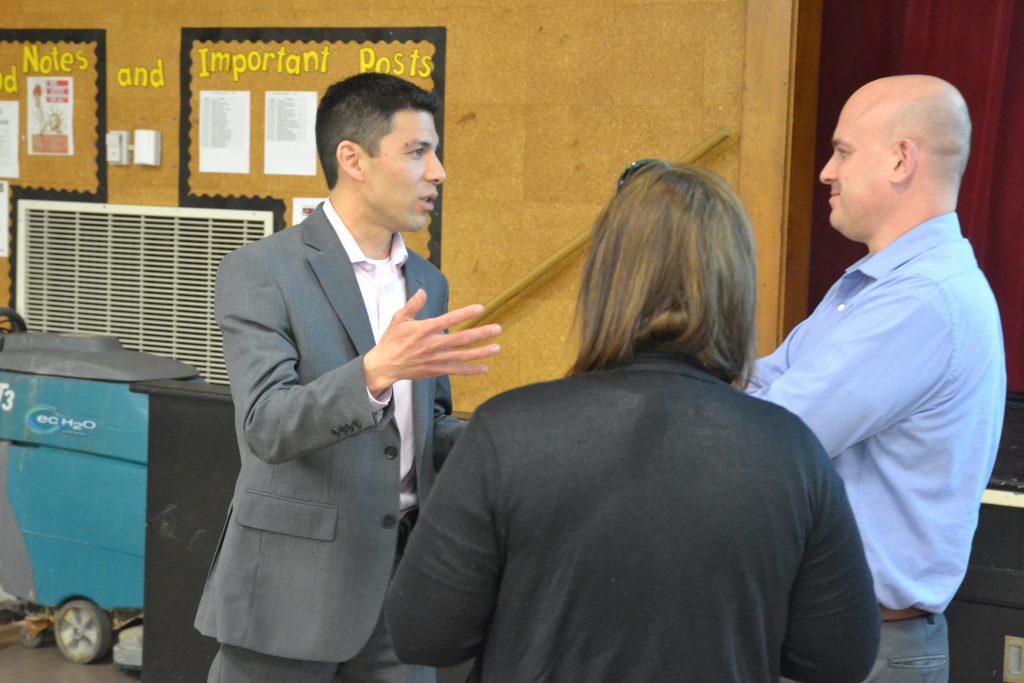

When it comes to statistics on childhood anxiety, the numbers may shock you. Recent studies by organizations such as Wolters Kluwer Health have shown 20 percent of school-aged children will suffer with some clinical level of anxiety in their lifetime.
According to psychologist Dr. Steven Tsao, when it comes to anxiety in their children, parents should know there is hope.
“Anxiety is very, very treatable,” said Tsao. “We should all be hopeful that if we find some kid that is really struggling with anxiety, that they can get better. This is not a life sentence, this isn’t a terminal illness, this is something that we can help them through.”
Tsao met with local parents at Burlington Township High School on Tuesday, April 30, to deliver his presentation on anxiety, entitled: When to Worry About Worry: Recognizing and Managing Anxiety Disorders in School-Aged Children.
Tsao is the co-founder of the Center for Anxiety and Behavior Therapy in Bryn Mawr, Pa., a specialty clinic focused on evidence-based care and treatment dissemination for obsessive-compulsive disorder and anxiety disorders.
Tsao first developed a fascination with the study and treatment of anxiety disorders in graduate school.
“I still remember the first case of OCD that I ever helped treat, and it was really enjoyable, it was incredibly challenging, and it was incredibly rewarding, so all of those things sort of led me to keep on specializing in this. That path from graduate school led me down other paths where I was always doing something around anxiety,” said Tsao.
Early in his presentation, Tsao drew a clear line between what is normal and what is abnormal when it comes to anxiety in young people.
According to Tsao, transitory fears that are normal during a child’s development include things like worrying about how they are perceived by their peers. It is only when anxiety and fearful responses reach such levels of intensity and duration that they begin to impair a child’s ability to function that they can be considered a disorder.
When it comes to specific types of anxiety, Tsao centered his presentation on three common anxiety disorders for young people: social anxiety disorder, generalized anxiety disorder and OCD.
While almost everyone can recall experiencing some level of social anxiety in their lives, either currently or when they were a child, Tsao again drew a line between what is normal and abnormal when it comes to this kind of anxiety.
According to Tsao, a child with social anxiety often shows abnormal levels of concern about how other people are going to judge them, that people are going to think they are strange or that they are going to do something embarrassing in a social setting.
“Their concern over being judged this way starts to meet that level where now we’re talking about clinical levels of anxiety, so it impacts the way that they socialize, it impacts where they’re willing to go, what they’re willing to do, what they have to do when they’re in these kinds of situations,” said Tsao.
Tsao described generalized anxiety disorder as someone you might refer to as a “worry wart,” a child who is constantly worried about lots of different things.
“It almost doesn’t matter what they are because the state of worry is just chronic. When one worry is resolved, another one comes into its place,” said Tsao.
Often these worries are over things that are reasonable, like their parent’s well-being, whether they will do well in school or whether their friends like them. According to Tsao, these common worries reach the level of a disorder only when they are constant. When there is always something that the child can’t get their mind off of.
Finally, Tsao identified signs of a child with OCD. He broke the classification down to the three letters of its title.
Obsessions are thoughts that pop into the child’s head they can’t get rid of, that make them anxious. Compulsions are things that the child does to cope with the anxiety that comes from the obsessions. As for the D in OCD, Tsao referred back to earlier in his presentation when he spoke about what classifies something as a disorder.
“It has to cause a significant amount of distress, or cause some kind of impairment in their daily lives,” said Tsao.
Tsao left parents with some advice should they identify these symptoms in their child.
Tsao reminded parents that anxiety is treatable. He suggested seeking out a psychologist if they believe their child is in need of medication. While pediatricians can write prescriptions, parents should be looking to someone who specializes in these types of disorders.
At home, parents can help their child by listening to their anxious concerns without dismissing them or trying to talk them out of it. According to Tsao, normalizing anxiety can go a long way as well.
“Being anxious is part of being a human being,” said Tsao. “It’s OK to tell your kid that you can be nervous about things.”
For more information about Tsao’s work at the Center for Anxiety and Behavior Therapy, visit centerabt.com.









